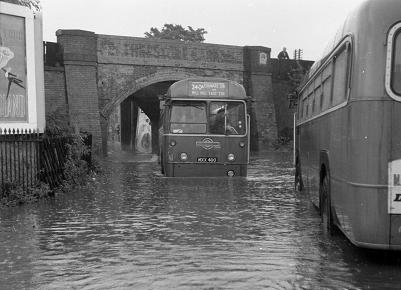 Red RF routes Red RF routes
Route
240A
Page last updated 1 January 2017
Much more famous for being the last route to operate the last
TDs, London's last half-cab single deckers, the 240A
became RF operated for a few years before the road was lowered
under the bridge at Mill Hill.
Just as Land Rovers can
have raised air intakes, the RF air intake is behind the
driver. Flood water therefore holds no fears for the driver
of RF423 as he heads west under the railway at Mill Hill into Hale
Lane; presumably his colleague will now decide to continue.
Further along Hale Lane, the ford across Deans Brook meant no buses
there until 1927.
Photo © David Smith
collection
Dates of RF operation
10 Oct 62 to 22 Jan 66
(total 3 years 3 months, all
crew-operated)
Destinations
EDGWARE STATION and MILL HILL EAST
STATION
Reason for single-deck operation
The low railway bridge at Mill Hill Broadway, before it was
reconstructed along with the building of the M1, meant the
double-deck 240 terminated east of the
bridge and the 140 to the west.
Earlier, the low bridge at Mill Hill East station (then Mill Hill
LNER station) restricted double-deck workings on the
240 to the section between Holders Circus and Golders Green,
until the road was lowered during the war.
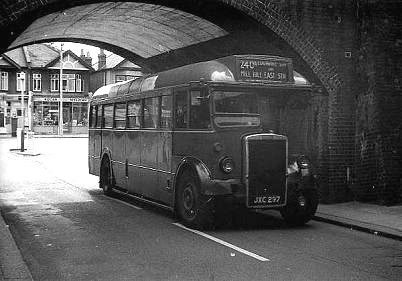 The low bridge at Mill Hill which caused single-deck
operation of the 240 A. TD104 heads into Mill Hill
Broadway from Hale Lane. See also here for a picture of the reconstruction in
progress. Another picture of the bridge is in John Hambley's
1962 book, showing TD101 coming the other way. Photo © Mike Beamish
Route history
On the same day in April 1922 as the 110 (later 210) was introduced to Golders Green, the General
introduced new route 104 linking Golders Green with Mill Hill,
both rapidly developing areas. The route was extended in
July alongside the new LCC Watling Estate via Deans Lane and
Deansbrook Road to Edgware and on to South Harrow. The
route was operated by Hendon garage (AE), this being some three
years before Edgware (EW) opened. The route
was single-deck operated due to the low railway bridge at Mill
Hill, but a supplementary double-deck service operated by
Cricklewood (W) ran between South Harrow and Harrow Weald, all
buses being B types.
In 1924, the double-deck section was extended, first to Stanmore
and then to Edgware, being renumbered 114 in December that
year. This replaced this section of the 104, which then
terminated at Edgware Station, with both routes now being operated
by W.
In October 1926, LGOC registered a route which extended the 104
beyond Golders Green along the 110 (now 210) as far as Highgate
Village. Although the full route (which ran north to
Elstree) never operated, the route ran between Edgware and Highgate
Village in summer 1927 only. Under the Bassom system, the previous 104 was
renumbered 104E and the Highgate route was numbered
104C. Perhaps in lieu of 104C, summer
1928 saw short workings on the 110 between Golders Green and
Highgate Village. Various other permutations of the 104 were
registered, ensuring confusion to historians and no doubt also to
passengers.
The present routing along Hale Lane to Edgware was introduced in
February 1929, when the route was extended in an S-shape to Burnt
Oak. The section of Hale Lane between the station and
the Green Man had been first used only in 1927 (by an
extension to the 114), before which the road had a watersplash at
Deans Brook and was unsuitable for buses.
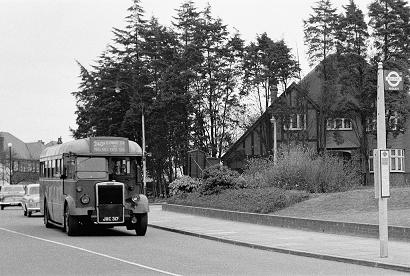
TD124 in smart suburbia on
2 Apr 62.
Photo © Geoff Plumb
The revolution in bus design that saw the double-deck LT and ST
classes and the single-deck Ts arrived early at Cricklewood, with
an allocation of the new T class from 12 Dec 29, a week after the
first of the type entered service in Romford. 13 buses
(T11-25 except for 15, 21) were allocated.
Two years later, and a year after Edgware garage (EW) started
working on the route, the 104 was the first to operate the new
single-deck LT Scooter, in January 1931. LT1001 was delivered
to EW (the parent garage was AE, so this was the official
allocation), enabling comparison with the Ts from EW and W as well
as the experimental single-deck London Six LS6 at W.
LT1001 moved to Muswell Hill for the 111 (later the 212) in March, but six and seven Scooters
respectively were delivered to EW and W for the route in June 1931,
replacing the Ts. By that time, the route again featured
a double-deck section, this time between Mill Hill East (south
of the station) and Golders Green, operated on Saturdays by
Chalk Farm (CF).
As primarily a single-deck route, the 104 was renumbered 240 in October 1934, when it operated
a fascinating mix of buses – as well as 3 Scooters from EW and 2
from W (and a Sunday allocation of 3 from Holloway (J)),
Cricklewood allocated one T and the LS, with NSs for the
double-deck section. These ran alongside STs from Edgware but
were replaced on Saturdays by STLs from Chalk Farm (CF).
The outbreak of war saw the allocation simplified, with just W
providing LT Scooters and STLs. A diversion via Sanders Way in Mill
Hill East was introduced in 1940, meaning the route no longer
served the LNER station, which had closed in 1939.
Mill Hill East station opened in 1867, on the GNR line from
Finsbury Park to Edgware via Highgate. This line became part
of the pre-war Northern Heights project, under which the Northern
Line would be extended beyond Highgate (the station now known as
Archway) over existing steam-operated rail lines. The line
from Finsbury Park had branches to High Barnet and Alexandra
Palace, and the plans also envisaged an extension north of Edgware
to Bushey Heath. Steam services ceased in 1939 and were
replaced (in part) by rail-replacement buses from Finchley Central
to Edgware.
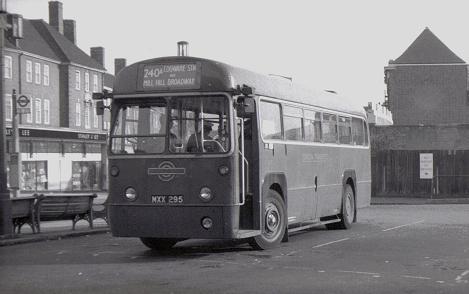
RF407 on the short-working to Mill Hill
Broadway.
Photo © Michael Rooum, Peter Gomm
collection
The war meant that the Northern Heights project was never
completed. The extension from Archway to High Barnet opened
in 1940, and to serve the Mill Hill Barracks the branch to Mill
Hill East was electrified and opened, still as a single track, in
1941 – the last element in today’s Northern Line. The
Alexandra Park branch, which passed under Muswell Hill by a weak
bridge that forced London Transport to work the busy 212 with single-deckers, continued to operate a
shuttle from Finsbury Park until 1954, but the section between Mill
Hill East and Edgware was freight only and never reopened to
passenger traffic; it closed completely in 1964. Despite
considerable work, including the building of the depot (which later
became LT’s Aldenham Works), the extension north of Edgware was
never built.
Returning to the 240, later in 1940 the single-deck section was
shortened to run only to Mill Hill Hendon Way, and the
allocation for this section moved back to EW; the double-deck
section was extended to run to Mill Hill (the Sanders Way diversion
avoiding the low bridge at Mill Hill East station). When Mill
Hill East station reopened in May 1941, the single-deck section was
extended to terminate there and the rail replacement service from
Finchley was withdrawn. By 1944, the road had been lowered
under the railway and the double-deck service resumed the former
through route. From 1945, the single-deck extension became
peak-hours only.
Being effectively a rail replacement service, certain
Underground tickets could be used on the 240 (later
240A). More information on this unusual
circumstance, and other examples we have discovered where rail
tickets were accepted on buses, are now on a separate page.
From being largely open country in 1930, the area around Mill
Hill was now becoming built up and new roads required new
services. In consequence, part of the 240’s single-deck
service was extended (using the same Scooters from EW) on 12 Nov 47
to Page Street, at the end of Bunns Lane, as new weekday route
240A.
In May and June 1949, Edgware's Scooters on the two routes were
replaced by nine new TDs, a year after Cricklewood's STLs on the
240 had been replaced by new RTs. The following year, the LMR
station at Mill Hill was renamed Mill Hill Broadway, but still only
offered the north-south service that is now Thameslink (officially
'First Capital Connect').
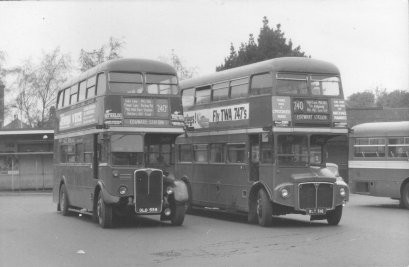 RT4772 (which in 2010 returned to the UK from
Canada) on the 240A and RM516 on the 240 share the stand
at Edgware Station. RT4772 (which in 2010 returned to the UK from
Canada) on the 240A and RM516 on the 240 share the stand
at Edgware Station.
Photo © N Rayfield, Ian
Armstrong collection
In July 1951, the 240’s single-deck section was withdrawn
completely and the 240A was extended (and made daily)
over the new Bittacy Rise and Pursley Road to Mill Hill East
Station. The new TDs were highly prized and thinly spread, so
when the service was increased on the 240A in November
1951, a pair of former Green Line 10T10s were required until a
couple more TDs could be found after the winter. Apart from
this period, the TDs settled into a routine throughout the
1950s.
The introduction of the RFs and in particular the service
reductions after the 1958 strike saw the TD fleet diminish so that
by late 1959 they were working only at EW and at Kingston, where
the 215A was deemed too tight
for RFs. These latter finally gave way in February 1962,
leaving the 240A to run London's last half-cab
single-deckers on 9 October 1962.
Throughout this period, the route had run a more frequent
service between Edgware and Mill Hill Broadway than further east,
with the short-workings described in the timetable as Mill Hill
Watford Way and on the blinds as Mill Hill Broadway.
The RFs continued this arrangement, running for just over three
years until more changes came to the 240 and 240A in
1966.
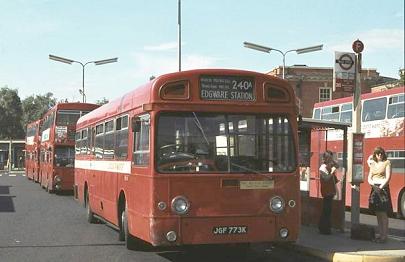 At the time of the building of the southern M1
extension, the road under the railway was lowered, permitting
through-operation by double-deckers. This was introduced on
23 Jan 66 by the extension daily of the 240 over its 'natural'
routing through to Edgware, using a mixture of RMs from Hendon, RTs
from Edgware and RTLs from Cricklewood. In addition,
trolleybus-replacement route 221 was
extended on Mondays to Saturdays from North Finchley to Edgware
over the full route of the 240A, replacing it on those
days. The 240A remained as a Sunday-only
route, now RT-operated and extended to Golders Green Station,
replacing half the Sunday service on the 240. At the time of the building of the southern M1
extension, the road under the railway was lowered, permitting
through-operation by double-deckers. This was introduced on
23 Jan 66 by the extension daily of the 240 over its 'natural'
routing through to Edgware, using a mixture of RMs from Hendon, RTs
from Edgware and RTLs from Cricklewood. In addition,
trolleybus-replacement route 221 was
extended on Mondays to Saturdays from North Finchley to Edgware
over the full route of the 240A, replacing it on those
days. The 240A remained as a Sunday-only
route, now RT-operated and extended to Golders Green Station,
replacing half the Sunday service on the 240.
This rather fragile arrangement lasted a further nine years,
with the RTs giving way to OMO SMSs in January 1971 and the route
finally being replaced by Sunday operation of the 221. The
last day of operation was 25 Mar 79.
SMS773 at Golders Green on a Sunday in the
1970s.
Photo © Paul Davis, Ian Armstrong
collection
RF route in detail, with timing points
EDGWARE LT Station, Station Road, Hale Lane,
Mill Hill Green Man,
Hale Lane, Mill Hill Broadway, Mill
Hill Broadway Flower Lane, Flower Lane, Bunns Lane,
Page Street Bunns
Lane, Page Street, Pursley Road, Sanders Lane, Bittacy
Rise, Engell Park, Bittacy Hill, MILL HILL EAST STATION

| Year |
Mon-Fri |
Sat |
Sun |
| 1951 |
12 mins |
10-15 mins |
- |
| 1953 |
8-12 mins * |
8-10 mins * |
15-16 mins * |
| 1959 |
6-15 mins * |
10-11 mins * |
16-18 mins * |
| 1964 |
9-15 mins * |
10-12 mins * |
24 mins * |
* more frequent Edgware - Mill Hill Watford Way
The route took about 20 minutes from end to end. The
July 1967 timetable, by which time the route was Sundays only,
RT-operated and ran through to Golders Green, is
here.
RF allocation
PVR 1962 (Oct): Mon-Fri 9, Sat 7, Sun 3
PVR 1963 (Oct): Mon-Fri 9, Sat 6, Sun 3
Memories
Alan Bond recalls Edgware
Garage in 1962:
When I transferred to EW in January 1962 after Colindale closed,
I was spare for a while and I got stuck on the 142 rota, a road
generally described as 'all brake and bell.' I worked with
various drivers for quite a while and did conducting duties on all
the EW routes at various times, including the 240A. After a
bit of wait I managed to get a slot on the 140 roster, first with
an ex-trolleybus driver named Wally, whose surname I cannot now
recall, and later with Joe Gowan who was my regular driver until I
went driving myself in 1964/65.
On the 140 rota we had two Sunday 'make up' duties on the 240A,
in those days TD operated. One of these had eighteen return
journeys between Edgware Station and Mill Hill Broadway, i.e 11 on
the first spell and 7 on the second. It was the only duty where you
needed a continuation waybill for your Gibson machine as each of
the 36 trips had to be accounted for individually and there were
only four values in use, i.e. 3d & 6d adult and 2d and 3d
child.
When the TDs were finally withdrawn in October 1962, we got a
little batch of red RFs without doors and these made quite a bit of
difference, especially as far as drivers were concerned. Due to the
fact that they had no doors, there was always a risk of runners
trying to get on at the last minute after the bus had started
moving and there were a number of incidents which gave cause for
concern, one of which led to a serious injury to someone who lost
their footing when trying to board while the bus was moving.
Fortunately, the front wheels were steering to the right but even
so, the nearside front wheel ran over this guy's foot and broke
several bones. After that it became the general practice for the
conductor to stand on the bottom step when leaving Edgware Station
to discourage late comers from attempting to board.
In February 1963 we received a further batch of RFs for the
251 road, which EW hadn't operated since
about 1942. This was a delightful road to work as the route took us
up through the more salubrious parts of Mill Hill and along
Totteridge Lane. We did have one 251 duty on the 140 rota and that
was a plum which many tried to get on to. Surprisingly, there
were quite a few staff who didn't like the 251 road and they would
willingly swap the duty for one on their own road. For a
while it was a middle turn but later it became a late turn which
included an unadvertised short working from Arnos Grove Station to
the Standard Telephone works up at Brunswick Park and back
again.
I also did this duty as overtime on my rest day once with an
elderly driver whose first name of Fred I can recall but but not
his surname and he was close to retirement. The first half
took over at Barnfield Road at Burnt Oak and we travelled down on
either a 142, 245 or 266 to take over the bus which we took back
into the garage for our break. The second half started at EW
sidecourt and, if I remember correctly, we ran light down to Burnt
Oak, a most unusual occurrence in LT days. We did three round trips
and then ran in to the garage in service, this time 'when working'
up the Edgware Road via the Bald Faced Stag. On each of the
three occasions that we stood at Arnos Grove Stn, my driver went
across to the pub (can't remember the name of it now) and had a
beer and by the end of the evening he was still as sober as a judge
and his driving was still smooth and immaculate, so he had
obviously had plenty of practice at both the beer and the following
driving. He probably felt that bus knew its own way home.
One of the 140 drivers (Alfie Harmes was his name) who
occasionally worked on the 251 road always referred to it as the
'sore shoulder' road due to the habit of passengers along
Totteridge Lane not ringing the bell but coming to the front and
tapping the driver on the shoulder and saying "Next stop please
driver."
When I passed out as a driver at the end of 1964, I was put on
to the 142 rota, a road that I detested even when the roster was
merged with the 292 so that we had alternate weeks on each
road. We also lost the 140 and gained the re-vamped 114,
which swapped ends with the 158 to run between Edgware Station and
Ruslip Lido. There were no early finishes on the 114 and the last
bus didn't get in to EW until almost 1 am. The 292 road had a
number of early finishes and I eventually solved the 142 problem by
volunteering for the staff bus duty on my 142 weeks.
This was a night shift which started at midnight and finished at
about 6 am and you did seven consecutive nights each of which paid
7hrs 36mins at double time, so I was quids in AND saved on beer as
I wasn't out at night drinking. The allocated bus was always
an RF and it was like owning your own personal bus as the garage
foreman was not averse to allocating your favourite bus if it was
available. The staff bus route was officially fixed but in
practice the driver would drop off staff as required and there were
three official routes which started off with the eastern area out
to Borehamwood and Elstree and points in between while the other
covered Stanmore, Queensbury and Kingsbury. One of our
drivers lived at Bushey Heath and it was always the done thing to
drop him off by the Three Crowns, unfortunately it would have been
closed by the time he got there.
I had occasion to drop someone off at Cricklewood one night and
coming back up the Edgware Road I saw a chap thumbing a lift
between Staples Corner and West Hendon so I stopped and he asked if
I was going anywhere near Edgware so I picked him up and dropped
him at the traffic lights by the Mason's Arms while I was waiting
to turn right and he slipped a crisp new pound note into my hand as
he got off - well, it would have cost him a lot more in a cab!
I made few bob like that on a number of occasions on the
staff bus and I was quite happy with a regular night shift even in
the winter as I would spend most of the night in the games room
playing snooker with the driver of the Underground staff bus, who
used to have his break at EW.
There was a regular staff bus driver who lived up by Rossington
Avenue at Borehamwood and if the driver of one of the late buses on
the 292 lived in Borehamwood he would swap over with him so that he
could go home while the staff bus driver took the bus back to the
garage to start his staff bus shift, all unofficial of course. As I
lived at Colindale, I was able to travel back and forth on the
Northern Line between home and Edgware. I was usually walking back
from the station at about 6.45 am and one week in the summer, on
each morning I heard a blackbird singing in the trees on the green
in Booth Road where we lived. On the Saturday I was disappointed to
be met with silence and the most stupid thought occurred to me that
the blackbird didn't work on Saturdays...!
The canteen that Edgware bus crews used (I remember it very
well) was actually provided as much for Underground staff as for
busmen. There was even a small canteen at Kilburn Park
Station which we used on the odd occasion when there was extra
stand time there at the time of day when the transition to peak
schedules on the 142 began. There was also a Sunday duty
which had about 23 minutes at KPS in the early evening. That one
was a bit annoying as it was a middle turn and you were finished
when you got back to Edgware and another crew on late turn took
over the bus to go to Watford.
On this particular occasion we pulled out on to the Kilburn High
Road and stopped at the first stop and a few got on so I checked
that there were no more and rang the bell but nothing happened. I
waited a minute or two before investigating and then the engine
stopped so I went around the back and along the offside to the cab
but my driver wasn't there. I walked across to the kerb and saw him
chasing a tall thin chap across the pavement, which was very wide
at that point. Apparently, this guy had run up to the bus and
banged on the bonnet and told Paddy that his mates were coming out
of the pub and to wait for them. Paddy said he wasn't going to
wait, whereupon the guy stood in front of the bus to stop it
moving. That was the point at which Paddy switched off the engine
and got down with the intention of shifting this guy out of the
way. This guy was about six foot thirteen but as skinny as
rake and Paddy was five foot four in his stockinged feet but
weighed about fourteen stone and I saw him chasing the other guy
across the pavement towards the shops and the next thing I saw was
Paddy pick him up bodily and hurl him through the window of the
furniture shop, which had this massive plate glass window which was
about eight feet by sixteen. The guy ended up on a sofa in
the front of the shop covered in glass and blood and someone called
the police, who were there like a shot (unlike today) so we were
stuck there until that was sorted out. Paddy was arrested and
carted off to the nick and the skinny guy was carted off to St
Mary's at Paddington in an ambulance. The result was that I got
overtime and Paddy got the sack. Fortunately he wasn't my regular
driver and I only worked with him on the odd occasion when I did a
rest day or some overtime.
He is also the only driver who ever put me on the floor, his
driving was so bad, so I guess he wouldn't have lasted much longer
as most conductors used to complain about him. My regular old mate
when I was on the 140 road was the late Joe Gowan and he could go
like the wind but I never had any problem with getting the fares in
and we very seldom finished late. I had a lady say to me
one day that she thought his driving was a bit fast so I told her
not to complain to Joe or else he would go really fast. The moral
of the story is, that if you want highly skilled and smooth drivers
for your buses you need to put conductors back on them. Very few
passengers will actually bother to complain about a driver but
conductors were always told to tell a driver if he was giving them
a rough ride. When I went driving, the first thing I said to
any conductor I hadn't worked with before was to tell me if I was
giving them a rough ride. A few did at first but I learned what was
needed and didn't get any complaints after that. Team
work!'
Re-creation
RFs operated the 240A at our Colindale Running Day in 2010.
|